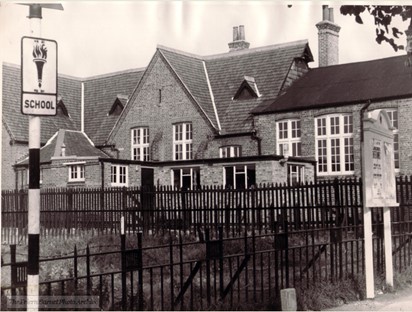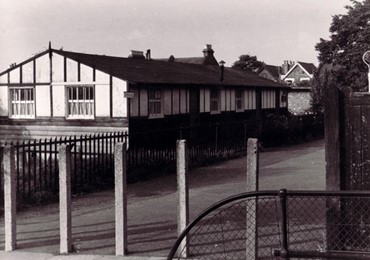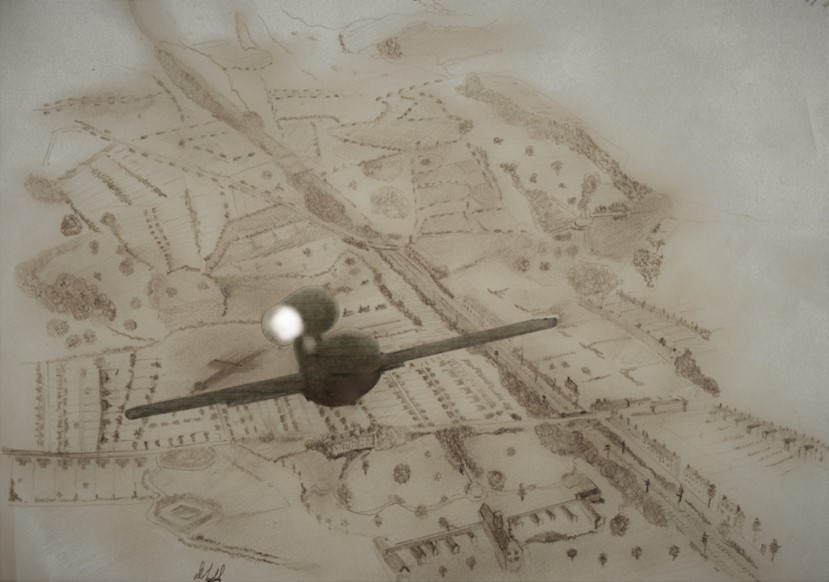St John’s School
When I was almost five, I started attending St John’s School.[21] Happy days, those I spent there at the little church school for boys and girls, just across the road from our house, on the bend of Goldsmith and Stanford Road. Boys attended only until seven, when they either went on to Holly Park or St James in Friern Barnet Lane. Between the school and the nearby Scout’s Hut[22] was an alleyway leading to Glenthorne Road.
My earliest days are clear. The first day, a lady in a flowered smock overall greeted us and showed me to Mrs Lewis’ class where we played with bricks, sand trays and round shiny coloured counters. At break we had milk and in the afternoon we had to lie down on the floor for a nap on raffia mats. When Mrs Lewis drew on the blackboard with her chalk, it turned out to be white although the outside of the chalk was yellow. I found this very strange.
‘Now who would like to go to the offices?’ she asked us.
This sounded interesting so I put my hand up, only to find out that it was a trip to the lavatories, housed in the cold windy building in the playground. The little toilets were draughty and not always clean, not a place to linger in on a cold winter’s day.
At the back of the playground was a built up rockery with shrubs and small trees, and at the edge were slanting flat stones we would sit upon if the weather was warm. Often we would play five stones or cat’s cradle.
The school itself was small, just six classrooms and mostly run by single ladies. Miss Bradley was Headmistress when I first started, and the other staff were Mrs Lewis, Miss Scoley, Miss Howard, Miss Parker and Mrs Diver. I will always remember the avenue of almond trees leading from the gate on Glenthorne Road, and a large Prunus tree on the Stanford Road front side. In the small playground, a huge heap of coal piled against the Stanford Road fence was a great attraction for the small boys, who clambered onto it at every opportunity, only to be told off by a stern teacher.
Being a church school, religious festivals were strictly kept, so most of us had learnt the hymns by heart. One of my favourites was the stirring ‘Onward Christian Soldiers’. We would walk in a crocodile formation—a two-by-two arrangement—with the teachers at the rear, up Stanford Road towards St John’s Church on Friern Barnet Road.
On Friday mornings the vicar would come to school to deliver a long session of prayers and hymns, which we didn’t mind too much, because that afternoon we would have something called ‘choosing’ which meant taking a toy or book of our choice to school or reading from the school library.
During the war years, we were given cod liver oil and extra milk to supplement the poor diet of rationing. Each child would line up for the fishy-tasting oil on a spoon, while the bottles of milk were left to warm by the coke boilers, which were stoked by the caretaker to heat the classrooms in cold weather.
If there was a raid during lessons, we had to stand quietly and leave the classroom single file, collecting our coats and gas masks as we left. Out of the school gate we went, across the alleyway and past the scout’s hut to a field at the back where underground shelters awaited us, bulging slightly under a grassy mound. On entering, we found ourselves inside a large concrete tunnel with wooden seats on either side, our feet on slatted wood covering the ground in case it rained, as it did get very wet being underground.
Once we were all assembled, the teachers would lead us into singing songs, the louder the better, to drown any noise of the raid going on overhead. ‘Ten Green Bottles Hanging on the Wall’ was a rousing song. ‘Ten in the Bed and the Little One Said Roll Over’ was another, as was ‘One Man Went to Mow’. We thought it all very good fun! Well, we did at the time.
When I was seven, I had to go to a different shelter located just beside the school. My sister Barbara told me years later how scared she was, because we were not in the same shelter together. Another of her worries was for our mum being at home. She was so afraid that our house would be bombed while we were at school, that she once went home at lunchtime instead of going into the school dining hall. Mum was surprised to see her, gently told her not to worry and took her back. My sister was of a more nervous nature than I was, suffering from nightmares and walking in her sleep.
We both settled down well at St John’s school. One of the teachers, an ageing lady called Miss Scoley, was very interested in Nature Study, as it was called then, so anyone who happened to bring tadpoles, newts or frogs was soon a great friend of hers. She was a very old-fashioned lady, even for that time, and definitely past retirement age, as teaching staff were needed and in short supply because of the war. I remember, her hair pinned back in a bun with straggling grey hairs coming out here and there, her mostly grey baggy cardigans worn over long skirts, and a blouse pinned at the throat with a cameo brooch. She seldom wore anything in fashion. My sister was a favourite of hers.
‘What have you there for me today Barbara?’ she would ask, kindly.
‘I’ve got some flowers for you Miss Scoley.’ A bunch of buttercups and dandelions with some old wild grasses would be handed to the teacher, who lovingly arranged them in a glass jam jar on the windowsill.
My favourite teacher was Miss Howard. She always looked so neat. I can see her now in a wine-coloured skirt and jacket, a string of beads at her throat, hair neatly brushed into place, a little lipstick, and powder for make-up. When she smiled her eyes crinkled at the edges. Always patient and kindly, she was also a wonderful storyteller.
I was a bit scared of Mrs Diver, who took us for History. Dressed in purple and grey, and with pince-nez glasses, I thought that she had a rather cross-looking face, but she could hold us spellbound with tales of the Saxons and Normans, King Harold and 1066.
I did get to like Mrs Diver eventually, because after the war, she selected myself and my cousin Jean to go with an older class (Year 1) on a day trip to Westminster Abbey. It was my first school trip and we had to draw a plan of the abbey before we visited, so that we understood every part of the building. We had a picnic sitting on the stone benches in The Cloisters and one of my friends was sick in Poet’s Corner.
After Miss Bradley left, Miss Courtney became Headmistress and there was not too many who liked her. She was tall and thin with a sharp nose, pink at the end, and her eyes protruded when she became angry. During one school dinner she stopped and spoke to my cousin Jean Lawrence.
‘What is that you are eating for dessert, Jean?’
‘It’s lemon turd cart and custard,’ my tongue-tied cousin replied, going red as a beetroot, really meaning to have said ‘lemon curd tart’. Miss Courtney moved on without a word, her lips tightly pressed together.
Once I had the misfortune to pass on a note that was being sent from one girl to another, and all those involved in this supposedly wicked deed had their hands slapped on the back until they stung. Miss Courtney’s eyes bulged as she ordered us to stand outside the classroom door. I usually behaved in class, so this was a terrible thing for me, but when I was outside in the playground, I would shout and act silly, the same as all the others.
We loved Christmas at St John’s School. Somehow, at the two other schools I attended when I was older, Christmas time never seemed the same. Perhaps being younger had something to do with it.
One particular Christmas, after the war ended, it was decided to have a pantomime. A Christmas Carol was chosen. I was disappointed at being chosen as a carol singer, because my friends had been selected for Tiny Tim, Christmas crackers, a Christmas pudding, ghosts, snowflakes and other much more exciting things. Oh well! As carol singers, we were asked to borrow top hats from wherever we could. Mum did not know anyone, so I ended up with a trilby and I felt so silly. Regardless, the show was a great success.
As soon as the foggy-weathered afternoons drew to a close, Mr Raymond, the caretaker, would come around with a long wax candle taper for the gas lights. He climbed onto the desk seats to reach each gas mantel, turning on the gas until it lit with a hiss and a pop. This ritual often distracted us from our lesson for a few minutes, but we soon paid attention again when the teacher clapped her hands to restore normal service.
But going back to the war, with the seemingly endless air raids and our usual strict home routine involving the sturdy Morrison shelter, we did get a shock one night. During one of the many skirmishes with the enemy, something heavy broke through the roof and bounced loudly down the stairs. Mum, scared out of her wits, pulled our coats on over our night things and we ran out into the street, thinking an unexploded bomb was in the house. Fortunately, it was only a very large piece of shrapnel, specifically, a lump of shell casing from one of our own guns at Whetstone.
Worse was to come: the V1 and V2 rockets. The V1, known as the Doodlebug,[23] could be clearly heard as a vibrant chugging sound, but did not always come during an air raid alert, and so many people were killed going to work during the day or at night when it was thought safe. If a V1 stopped suddenly overhead, that was it, and a whole street could be destroyed. Wherever we were, it was best to take cover if one was heard approaching. If that was not terrifying enough, the V2 had no sound and could not be seen.
During that time we were evacuated. The first I remember of it, was when Mum took us to Finchley to buy new things from Timothy Whites, the chemist, who sold almost anything beside the medicines. New underwear, shoes and two pixie hats made from silver mackintosh material were selected for us. It was like preparing for a very long holiday.




Leave a Reply